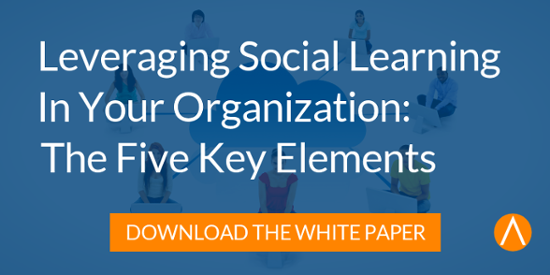Posted by Jeff Carpenter ● July 21, 2017
Mining for Gold Among Learning Trends of Today and Tomorrow
 A number of trends in learning & development are exciting and promising… but not all that glitters is learning gold. What's important is not necessarily that learning leaders jump on trends, but that they pay attention to them to assess whether or not their organization would benefit from them.
A number of trends in learning & development are exciting and promising… but not all that glitters is learning gold. What's important is not necessarily that learning leaders jump on trends, but that they pay attention to them to assess whether or not their organization would benefit from them.
Learning is getting more customized, more adaptive, and made available however and wherever—and budgets are not increasing at the same rate as expectations. Don't let technology overshadow your business aims; there’s a tendency for learning organizations to address technology first, and then figure out after the fact how they’ll use it and how it's going to impact the user base. Above all, make sure your L&D organization is not simply ahead of the curve, but is innovating to drive actual enterprise-wide benefits.
Here’s a look at some of the learning trends generating buzz throughout L&D, and our assessment of their potential value.
Metrics and Measurement
Before funding any L&D initiatives, the C-suite is increasingly demanding that learning leaders provide detail on the business case. That the learning function is being expected to drive business value—and be able to do it in a measurable way—is long overdue. Employ learning metrics and measurement so that at the end of the initiative, the learning organization is able to show the business exactly what success has been accomplished. If learning leaders want the credit they deserve for closing performance gaps, they need to identify, quantify, and track the metrics that go into achieving organizational objectives and bottom-line success.
Glitter or Gold: A golden goose
Outlook: This shouldn’t really be a trend, honestly, because everyone should already be doing it.
Customizable Learning
 The maturity of HTML5 and the emergence of xAPI means customizable learning is continuing to gain momentum. xAPI has been slow to take off, mainly because the development tools remain challenging to use for non-experts. Those development tools are starting to become more intuitive, however, allowing more learning organizations to leverage the technology without having to do too much custom coding—and to do so in a platform-agnostic way. As a result, expect to see more customizable learning in the near future.
The maturity of HTML5 and the emergence of xAPI means customizable learning is continuing to gain momentum. xAPI has been slow to take off, mainly because the development tools remain challenging to use for non-experts. Those development tools are starting to become more intuitive, however, allowing more learning organizations to leverage the technology without having to do too much custom coding—and to do so in a platform-agnostic way. As a result, expect to see more customizable learning in the near future.
xAPI is creating a standard for capture analysis and customization of the learner's experience. xAPI itself allows for learning paths to be customized to each learner's specific needs and allows them to learn at their ideal speed. It not only lets learners interact with the content, but the system itself can understand whether the individual requires more reinforcement or is ready to move ahead.
Glitter or Gold: More gold than glitter
Outlook: Customizable learning will eventually achieve widespread adoption, but it could be a couple years before that wave really starts to build.
Adaptive Learning
As sophisticated artificial intelligence becomes increasingly accessible, adaptive learning will begin edging into the mainstream. Adaptive learning is the holy grail of L&D—learning that is truly personalized to the individual. Using algorithms, deep analytics, and AI, adaptive learning is a future technology that's going to revolutionize our industry. It's rather rudimentary right now, but the idea is that the system determines an individual user's unique performance support needs based on job requirements, skill and knowledge assessments, and near- and long-term career goals, and it generates a learning plan and content recommendations specific to that individual. Two people could be performing the exact same role, yet have wildly different learning experiences based on those other factors. The system continually looks at each individual and how they're growing in their role, and continues to run that algorithm.
This will spell the end of all learners in an organization or role navigating through tight, rigid curricula, and they can instead self-access a series of learning experiences that are customized to help them achieve personal and professional goals. Beyond the obvious theoretical benefits to the individual learners, an adaptive learning system could offer executives tremendous insight into personnel needs and organizational strengths, allowing them to optimize resource development budgeting and workflow balancing.
Glitter or Gold: End-of-the-rainbow stuff
Outlook: True adaptive learning is probably three to five years from bleeding-edge implementation, and may not be mainstream for a decade or more… but it’s coming.
Learning Content Curation
 One of the hottest L&D trends right now is learning content curation. A generation ago, curation was known as knowledge management, during an era when a worker’s knowledge was precisely what made them valuable to an organization. Nowadays, most information is widely available and accessible at the click of a mouse or the tap of a screen, and so possessing knowledge is less important than being able to retrieve it. Thus, a major responsibility of today’s instructional designers is curation—sifting through all that content to identify what is best and most relevant for the learners and how to make it available when they need it and in a format that is easy to consume. Because let’s face it: while some of the content is great, much of the content is mediocre, and most of it is typically bad or useless.
One of the hottest L&D trends right now is learning content curation. A generation ago, curation was known as knowledge management, during an era when a worker’s knowledge was precisely what made them valuable to an organization. Nowadays, most information is widely available and accessible at the click of a mouse or the tap of a screen, and so possessing knowledge is less important than being able to retrieve it. Thus, a major responsibility of today’s instructional designers is curation—sifting through all that content to identify what is best and most relevant for the learners and how to make it available when they need it and in a format that is easy to consume. Because let’s face it: while some of the content is great, much of the content is mediocre, and most of it is typically bad or useless.
Instead of recreating the wheel each time, curation means identifying the best of what already exists and piecing it together in a way that addresses the underlying performance issues. This doesn't mean that learning professionals will stop creating content—far from it. Our industry will always be in the content creation space; it's just going to be less. But the notion that instructional designers are becoming more like librarians than authors is a bit overblown.
Glitter or Gold: Gold… but only when done well
Outlook: Curation will continue to become a bigger and bigger piece of the L&D industry.
Mobile Learning
The traditional learning paradigm—on somebody else's schedule, at a predetermined time or at a designated location—is outdated. We need to engage learners and create performance solutions that support the user population however and whenever they want to consume it. Mobile learning has seen a number of false starts over the past decade, but with the advent of native or HTML5 responsive design, it's now relatively easy to create platform-agnostic performance support tools. It’s no longer necessary to go through a predefined app or partner with IT organizations on development, which will allow mLearning to really blossom in the near term.
Glitter or Gold: Gold sprinkled with glitter
Outlook: It won’t be long before mLearning moves from trend to standard modality, if it hasn’t already.
Microlearning
 There is a definitive move toward microlearning, which is emerging as the bridge between the most expansive programs of learning and the support of performance within the workflow of day-to-day operational users. Microlearning reduces time away from the job, providing faster, more focused learning, available in the moment of need. It leverages new methodologies and techniques to deliver learning in short bursts, and it's meant to create ongoing learning support to reinforce knowledge and skills outside the classroom. It allows for the continuous reinforcement that's needed to ensure that the behavior, skills, and knowledge transfer is sticky. The best microlearnings are learning opportunities that can be more readily consumed within a normal workday; instead of making time for learning, it just becomes part of the normal workday. And it needs to be short, sharp, and memorable, and typically three to five minutes long.
There is a definitive move toward microlearning, which is emerging as the bridge between the most expansive programs of learning and the support of performance within the workflow of day-to-day operational users. Microlearning reduces time away from the job, providing faster, more focused learning, available in the moment of need. It leverages new methodologies and techniques to deliver learning in short bursts, and it's meant to create ongoing learning support to reinforce knowledge and skills outside the classroom. It allows for the continuous reinforcement that's needed to ensure that the behavior, skills, and knowledge transfer is sticky. The best microlearnings are learning opportunities that can be more readily consumed within a normal workday; instead of making time for learning, it just becomes part of the normal workday. And it needs to be short, sharp, and memorable, and typically three to five minutes long.
Glitter or Gold: Gold
Outlook: Microlearning is here for the long haul, and while it’s only one component of a successful learning strategy, it’s an important one.
Virtual Reality
Virtual reality still mainly resides in entertainment, and it’s no sure thing that VR will ever become mainstream within the business world. Besides obvious hurdles around logistics, development cost, equipment, and maintenance, there are some serious questions about its actual value as a learning tool. The human brain relies on the various senses with regard to knowledge acquisition and recall—it’s why songs and smells and tastes can suddenly trigger memories. For the most part, VR only relies on two senses—sight and sound—while ignoring smell, taste, and touch, which essentially makes it a highly interactive form of eLearning. Nothing wrong with that, per se, but it means VR is rarely the most sensible design option when factoring the accompanying cost and logistical challenges. Virtual reality technology as it currently exists can't replicate the real environment enough to trick our brains into thinking it's a real experience, nor does it encode memories as well as the real world does.
Glitter or Gold: World’s most expensive glitter
Outlook: Expect slow but steady growth over the next decade, though VR in a learning context may not become truly mainstream for a long time, if ever.
Augmented Reality
On the other hand, VR’s cousin, augmented reality, holds tremendous promise for L&D. AR basically takes the real world environment and overlays additional content on top of it. Because it exists in the real world, it’s inherently more personal and more social. Unlike virtual reality, augmented reality does allow for those additional senses to act as memory markers. It also allows for performance support in real time, to help learners perform better in the course of their normal daily work. Trainers can remotely see what the learner is seeing, and they can work through issues together—it's really a more authentic experience. Development and maintenance are much less expensive than VR, too. While current AR technology is still somewhat rudimentary, it's evolving rapidly. Most learning leaders strategizing for the medium-term would be wise to focus more on AR than VR.
Glitter or Gold: Solid gold
Outlook: Mainstream adoption will accelerate around 2019 or 2020, and sky's the limit for potential learning applications.
Social Learning
 Social learning, or what some like to call the “digital water cooler,” is one of the fastest-growing tools for enterprise learning. The vast majority of organizations say they want to support knowledge sharing throughout the business, and the use of in-house social networks is the most common solution. Social learning tools should encourage easy, open collaboration, and when it becomes a normalized part of the everyday workflow, that's when it's most likely to be used and become deeply embedded in the fabric of the organization. The focus on social sharing aspects may be unnecessarily competing with existing social media platforms outside the organization, so it’s important to delineate between social learning and social media platforms.
Social learning, or what some like to call the “digital water cooler,” is one of the fastest-growing tools for enterprise learning. The vast majority of organizations say they want to support knowledge sharing throughout the business, and the use of in-house social networks is the most common solution. Social learning tools should encourage easy, open collaboration, and when it becomes a normalized part of the everyday workflow, that's when it's most likely to be used and become deeply embedded in the fabric of the organization. The focus on social sharing aspects may be unnecessarily competing with existing social media platforms outside the organization, so it’s important to delineate between social learning and social media platforms.
Glitter or Gold: Golden glitter
Outlook: There's clearly an appetite for social learning, and demand for collaborative learning platforms will continue to grow in 2018 and beyond.
Talent Management Analysis
Our friends in HR are getting the message that they also need to start looking more intensely at data analytics. The old joke that HR likes to measure everything, just not themselves, may finally become outdated. The Conference Board ranks human capital as the number one challenge facing global CEOs today. In fact, it's been such a tough challenge for such a long period of time that while CEOs and board members fully understand the value of human capital, they also have learned to expect a higher rate of strategic change than most HR functions have been able to deliver. So while talent management is seen as an urgent priority, knowledge about the workforce is typically limited to isolated metrics, due to the way talent management has evolved in multiple silos.
The Harvard Business Review found that firms that effectively manage their workforce using analytics grew profits by more than 65%. Analytics can also be used to optimize hiring practices by quantifying the impact of any increase in productivity, and to identify specific worker behaviors and attributes that are needed. Finally, having solid analytics and metrics allows the organization to understand exactly which initiatives are truly driving business value, and which are not.
Glitter or Gold: Gold
Outlook: If your organization isn’t doing this, it's probably time to start.
Performance Consulting
 Focusing first on performance, not training, is the new normal. This means shifting away from just training as the default setting, and instead working with stakeholders in a consultative fashion to understand root causes and optimal performance interventions. We're seeing considerable movement inside learning organizations to drop the all-too-common order-taker mentality, and instead to help craft the solutions, because not all solutions should be training-related, frankly. This takes a higher degree of business acumen among learning professionals in order to gain credibility and have a better understanding of how the business operates, so that as they're consulting with stakeholders, they have a broader frame of reference.
Focusing first on performance, not training, is the new normal. This means shifting away from just training as the default setting, and instead working with stakeholders in a consultative fashion to understand root causes and optimal performance interventions. We're seeing considerable movement inside learning organizations to drop the all-too-common order-taker mentality, and instead to help craft the solutions, because not all solutions should be training-related, frankly. This takes a higher degree of business acumen among learning professionals in order to gain credibility and have a better understanding of how the business operates, so that as they're consulting with stakeholders, they have a broader frame of reference.
Glitter or Gold: A gilded tower filled with gold bars
Outlook: Not just a trend, it’s the future of L&D.
Gamification
In the right context, gamification can be a great tool, and it should be part of most instructional designers’ tool belt… but it’s not a destination deliverable in and of itself. It's expensive and time-consuming to develop and maintain, and the results that are being driven from it don’t often justify the effort and expense.
Glitter or Gold: The shiniest of objects
Outlook: Gamification is not going away, but we’re skeptical of its value.
Jeff Carpenter is founder and CEO of Caveo Learning. He has presented at some of the nation’s foremost learning & development conferences, including Elliott Masie’s Learning, the Corporate L&D Institute, the Learning Leaders Conference, and the Center for Talent Reporting’s Annual Conference, as well as the Society for Human Resource Management’s International Conference. Carpenter has been published in Chief Learning Officer, Learning Solutions Magazine, Training, CIO, and Workforce, among others. He holds a master’s in training and development from Roosevelt University and a bachelor’s in human resources from the University of Nebraska.
Topics: Learning Trends

